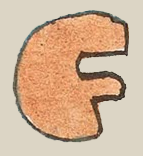tentli (Mdz51r)
This element showing lips (tentli) has been carved from the compound sign for the place name, Atenco. In that compound the tentli played a phonetic role, but here, isolated, they are a logogram. The lips are expressed as half a face, including the lips, some of the one cheek that appears (given this is a profile, facing right), and the chin. This partial face has a terracotta skin color.
Stephanie Wood
Glyphs for tentli will often have more than just lips. Sometimes the jaw or chin are even more prominent than the lips, and we have one example that is an entire head. See various examples below.
Stephanie Wood
c. 1541, or by 1553 at the latest
Stephanie Wood
lips, edges, bordes, labios, mentón, barbilla

ten(tli), lip, edge, https://nahuatl.wired-humanities.org/content/tentli
los labios
Stephanie Wood
Codex Mendoza, folio 51 recto, https://digital.bodleian.ox.ac.uk/objects/2fea788e-2aa2-4f08-b6d9-648c00..., image 112 of 118.
The Bodleian Libraries, University of Oxford, hold the original manuscript, the MS. Arch. Selden. A. 1. This image is published here under the UK Creative Commons, “Attribution-NonCommercial-ShareAlike 3.0 License” (CC-BY-NC-SA 3.0).






